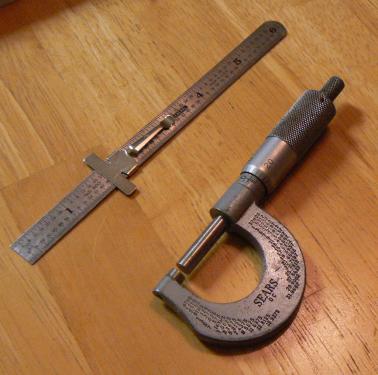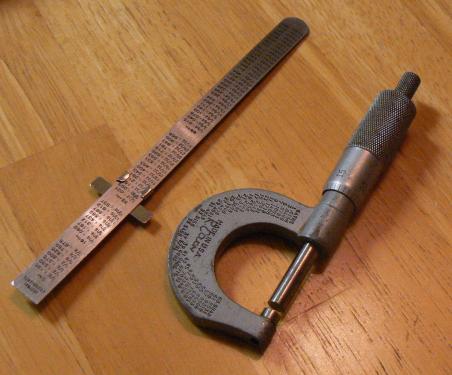Posts: 215
Threads: 22
Joined: Jul 2017
Location: Eureka, CA, USA
Tom, that's definitely understandable - I wouldn't want to scratch my "General" six inch scale, with original pocket clip, that I've owned for over fifty years (are those even made now ?).
But I have half a dozen $2 scales (and $15 dial calipers) around the shop in various places so not really a problem with damaging them. And there's always the option of just using a piece of scrap rather than a scale for the purpose, in fact a spare parting blade would be ideal.
Anyway, the main point was to make a fifteen-twenty second trial cut on the face of a piece of stock, adjust the blade so that the tit is cut off - done. No need to change the height setting until the next time the blade is sharpened, right ?
Regarding using the tailstock center to set tool height, here is a trick from years ago. After setting the tool height to one's satisfaction by whatever method, move the carriage and cross-slide so that the sharp tool touches the side of the tailstock quill near the front. Scribe a short line on the side of the quill with the tool by moving the carriage.
Cutting tools can usually be set to height by aligning the cutting edge with the scribed line even when there is a drill chuck installed or when there is work between centers. This is mostly useful for lantern toolposts but can work for quick change holders too.
Posts: 432
Threads: 27
Joined: Feb 2016
Location: Woodstock:GA
(03-18-2018, 11:09 PM)randyc Wrote: Tom, that's definitely understandable - I wouldn't want to scratch my "General" six inch scale, with original pocket clip, that I've owned for over fifty years (are those even made now ?).
But I have half a dozen $2 scales (and $15 dial calipers) around the shop in various places so not really a problem with damaging them. And there's always the option of just using a piece of scrap rather than a scale for the purpose, in fact a spare parting blade would be ideal.
Anyway, the main point was to make a fifteen-twenty second trial cut on the face of a piece of stock, adjust the blade so that the tit is cut off - done. No need to change the height setting until the next time the blade is sharpened, right ?
Regarding using the tailstock center to set tool height, here is a trick from years ago. After setting the tool height to one's satisfaction by whatever method, move the carriage and cross-slide so that the sharp tool touches the side of the tailstock quill near the front. Scribe a short line on the side of the quill with the tool by moving the carriage.
Cutting tools can usually be set to height by aligning the cutting edge with the scribed line even when there is a drill chuck installed or when there is work between centers. This is mostly useful for lantern toolposts but can work for quick change holders too.
When I first got the machine after determining the first tool hight. As you describe, implemented the use of the tailstock for the tool set up, simple logic .
But leaning down to see a scribed line, and second guessing the viewing angle. This silly little indicator streamlines the set up. For grins after first using the gizmo. I dug out the other tool blocks and checked them, amazed to find only 3 out of the 8 were off a RCH .
Point being both techniques are valid, it definitely comes down to a machinists preference. I to am interested to see Tom's design, I liked the fence he did for the bandsaw.
Greg
"General" six inch scale, with original pocket clip, that I've owned for over fifty years (are those even made now ?).
 2 bucks
https://www.walmart.com/ip/General-Preci...n/17038024
Magazines have issues, everything else has problems
Posts: 215
Threads: 22
Joined: Jul 2017
Location: Eureka, CA, USA
03-19-2018, 09:14 PM
(This post was last modified: 03-19-2018, 09:35 PM by randyc.)
I don't think that the leveling bubble device is "silly" to the contrary, my description was "ingenious". I have no intention of trashing the tool but just to note that - for me at least - it would be unnecessary and might not provide the desired result.
For example, there are many, many applications where one doesn't even WANT the tool to be on center. One reference (one of many) is found on page 28 of the following:
http://campkahler.com/files/How_to_Run_a...B_1of2.pdf
Ignoring THAT bowl of worms, my point was/is that the best way of evaluating a cutting tool's performance is to make it perform. If a parting tool cuts to the center of the work, removing the tit, then IMO it is properly adjusted, regardless of whatever technique was used to get it there.
If it takes seconds, rather than minutes, to make a cut or two, adjust as required and lock the tool in place, so much the better.
How one determines the proper tool setting isn't particularly important, as you say, if the process is satisfactory. There are many methods, all of them successful when the operator applies them based on personal experience of what works ... The scribed line on the tailstock quill, by the way, was simply an example of one of those methods, not necessarily a recommendation.
I'm going to take a wild guess that the "General" scale sold by Walmart is not made in this country, if that's meaningful to anyone (besides moi).
Posts: 432
Threads: 27
Joined: Feb 2016
Location: Woodstock:GA
The following 1 user Likes pepi's post:
randyc (03-20-2018)
I used the term silly as to not wear out gizmo, to many gizmos are not good. I'm inexperience but on the same wave length as yourself. Thus making a reference to the tailstock mod, hell I thought it was a trick mod when I thought of it.
Using a test cut across the face of round bar. Was the way I found tool cutting hight, learn that most likely here.
I was making spacers for a hyme joint, base material was a tube, test cut would not have worked. The experienced machinist can tell a tool is not set correctly in short order. As the machining begins, which is an even bigger advantage when using the parting tool.
Wallmart scale .... just pointing out that General was still making or at least branding a 6" , You're likely correct in thinking it maybe foreign made ....... humor does not always come thru typing stuff, eye too eye a smile tips that off, wink also..
Cheers,
Magazines have issues, everything else has problems
Posts: 2,596
Threads: 99
Joined: Dec 2014
Location: Michigan
The following 1 user Likes Vinny's post:
EdK (03-20-2018)
They don't say where that General scale was made. Not on the package or the scale itself (unless it's on the back). But the ad says it's metric and imperial. The picture shows 64ths and 32nds and the reviews say it's imperial only. So...
Posts: 685
Threads: 42
Joined: Mar 2012
Location: Rochester, NY
The following 1 user Likes rleete's post:
randyc (03-20-2018)
03-20-2018, 06:20 PM
(This post was last modified: 03-20-2018, 06:25 PM by rleete.)
Current production of 6" scales with the black printed markings are from India. Previous versions have come from Taiwan. They used to be made in upstate NY.
Edit: Pictures of the ones with the pocket clips on Amazon show "Made in USA" printed on them. It's only the really cheap ones made in India.
Full of ideas, but slow to produce parts
Posts: 215
Threads: 22
Joined: Jul 2017
Location: Eureka, CA, USA
The following 1 user Likes randyc's post:
f350ca (03-21-2018)
Dang man, that's some impressive history (cool car too)  I noticed that you live in N.Y. did you happen to work for General Tools ?
I don't know how old my little scale is, it was part of a package that came with the first lathe (6 inch Atlas) that I bought just after my Army discharge in '68. Unhappily I've lost almost all of my hand tools from that period, I've managed to keep only these two:


I have no idea how much the scale cost but the micrometer was $4.79 (or thereabout) plus sales tax, and it was also obtained in 1968. That was cheap even in that year.
Maybe the reason for the low cost was the aluminum frame. If the micrometer frame is held in the hand for three or four minutes and the shop temperature is (typically) 60 degrees F, there can be an error as much as .001 (maybe more).
But for a hobbyist, it was plenty accurate and given my pitiful financial situation, I was proud to own it - even engraved my name on the frame as can be seen ! And it is still quite accurate when it is allowed to come to shop temperature for a while and not held in the hand improperly or for too long -
Posts: 685
Threads: 42
Joined: Mar 2012
Location: Rochester, NY
I got all the info off the General website. They are still based in NY. No, I never worked for them.
Full of ideas, but slow to produce parts
Posts: 432
Threads: 27
Joined: Feb 2016
Location: Woodstock:GA
The following 1 user Likes pepi's post:
Mike E. (03-21-2018)
I guess as long as a corporation's home is US based it's ok to keep buying a product ?
Magazines have issues, everything else has problems
Posts: 215
Threads: 22
Joined: Jul 2017
Location: Eureka, CA, USA
Good question.
Buying Chinese products (and contributing to the loss of jobs in this and other countries) is a tough call. I believe in NOT buying Chinese stuff where possible but that may be a naive attitude. Sometimes it's not possible to obtain a specific item any other way and that's the classic illustration of other companies being bankrupted by inexpensive imports.
But, that is capitalism at work and the result of so-called "globalism" which, it strikes me: is that really a "word" ?
Personally, I am a hypocrite about boycotting goods that aren't manufactured in North America (BTW Canadian and Mexican products are just fine as far as I'm concerned although some would say that they are in the same category as Chinese and Indian imports). I buy cheap products occasionally just for the reason that they don't cost much.
Every time I do this, I feel a slight sense of shame because I am vocal about these things with friends and associates. As an example, the protractor that was discussed in this thread previously. That device was made in China and I didn't even NEED the thing yet I purchased it without a qualm. That's a classic case of conveniently ignoring my convictions !
If pepi's question is a serious one and if I was faithful to my convictions, no it wouldn't be OK to buy offshore products when the "brand" lives in this country. It's tempting to blame the greed of corporations with offshore manufacturing for the loss of their employees. But that's not the whole story and we know it. It's possible - even likely - that ALL of their employees would be out of work should the company not be competitive.
The situation is just as complex as decisions I (and others) make when we consider a purchase. As I said, I'm sometimes a hypocrite.
|





 2 bucks
2 bucks
 I noticed that you live in N.Y. did you happen to work for General Tools ?
I noticed that you live in N.Y. did you happen to work for General Tools ?